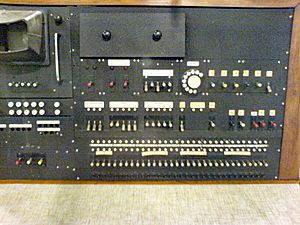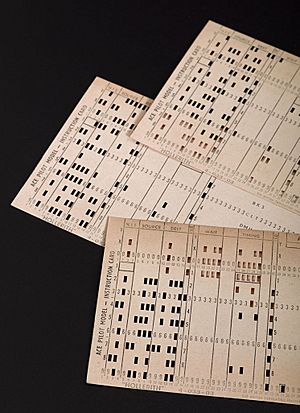Pilot ACE facts for kids
 |
|
| Developer | National Physical Laboratory (NPL) |
|---|---|
| Release date | 1950 |
| CPU | approximately 800 vacuum tubes @ 1 megahertz |
| Memory | 128 32-bit words; later expanded to 352 words (Mercury delay lines) |
The Pilot ACE (which stands for Automatic Computing Engine) was one of the very first computers built in the United Kingdom. It was created at the National Physical Laboratory (NPL) in the early 1950s. This machine was also one of the first computers that could be used for many different tasks and store its own programs. It was a smaller, test version of a bigger computer called the ACE, which was designed by the famous mathematician Alan Turing. Turing left NPL before the Pilot ACE was finished.
Contents
How the Pilot ACE Computer Was Built
The Pilot ACE was a simpler version of Alan Turing's original ACE design. After Turing left NPL, James H. Wilkinson took over the project. Other important people involved in its design included Donald Davies, Harry Huskey, and Mike Woodger.
The Pilot ACE ran its very first program on May 10, 1950. It was shown to the public and news reporters in November 1950. Even though it was meant to be just a test model, people soon realized how useful it could be. This was especially true because there weren't many other computers around at that time. After some improvements, it started working full-time in late 1951. It was used a lot over the next few years.
One reason the Pilot ACE was so helpful was its ability to do floating-point arithmetic. This is a type of math that is very important for scientific calculations.
Math on the Pilot ACE
When it was first built, the Pilot ACE did not have special parts to do multiplication or division. Other computers at the time usually had these. Instead, the Pilot ACE used software (programs) to do these calculations. It started with something called fixed-point math. However, numbers quickly became too big or too small for this method.
It didn't take long to write new software so the Pilot ACE could do floating-point math instead. This made calculations much more accurate. James Wilkinson became an expert in this area. He even wrote a book about rounding errors in floating-point calculations, which became very popular.
What Was Inside the Pilot ACE?
The Pilot ACE used about 800 vacuum tubes. These were like old-fashioned light bulbs that helped the computer process information. Its main memory used mercury delay lines. This was a way to store information using sound waves traveling through mercury.
The computer could originally store 128 "words" of 32 "bits" each. This was later increased to 352 words. In 1954, a larger drum memory was added, which could store 4096 words. The Pilot ACE's basic speed, called its clock rate, was 1 megahertz. This made it the fastest of the early British computers.
How fast an instruction ran depended on where it was stored in the memory. An addition could take anywhere from 64 to 1024 microseconds.
The Pilot ACE's Legacy
The Pilot ACE was so successful that a commercial version was made. It was called the DEUCE and was sold by the English Electric Company.
The Pilot ACE was turned off in May 1955. It was then given to the Science Museum in London, where you can still see it today.
Software for the Pilot ACE
When the magnetic drum was added in 1954, it allowed for new programs to be developed. One important program was called the General Interpretive Programme (GIP). Brian W. Munday created GIP. It made it easier to run different math problems, especially those dealing with large groups of numbers called "matrices."
GIP used simple commands to run smaller programs called "bricks." Each brick could do one specific task. For example, one brick might solve a set of equations, while another might multiply matrices. What made GIP special was how simple its commands were. You didn't have to tell it the exact size of the numbers you were working with. The program figured that out from the data itself. This meant that once a program was written, it could work with different sizes of numbers without needing to be changed.
GIP was running in 1954. It was later rewritten for the DEUCE, which was the next computer after the Pilot ACE.
How Numbers Were Stored
M. Woodger wrote the "bricks" programs for GIP. He came up with a clever way to store numbers called "block floating." Normally, to store a number with high accuracy, you might need two "words" of memory for each number. To save space, Woodger used only one "word" for each number in a group. He did this by using a single "exponent" (a scaling factor) for all the numbers in that group.
This meant that only the largest numbers in the group were perfectly scaled. Smaller numbers were scaled based on that same exponent. While this caused a tiny loss of accuracy for the smaller numbers, it wasn't a big problem. This was because the numbers in these groups usually weren't too different from each other. The exponent and the size of the group were stored along with the numbers.
See also
- List of vacuum tube computers



